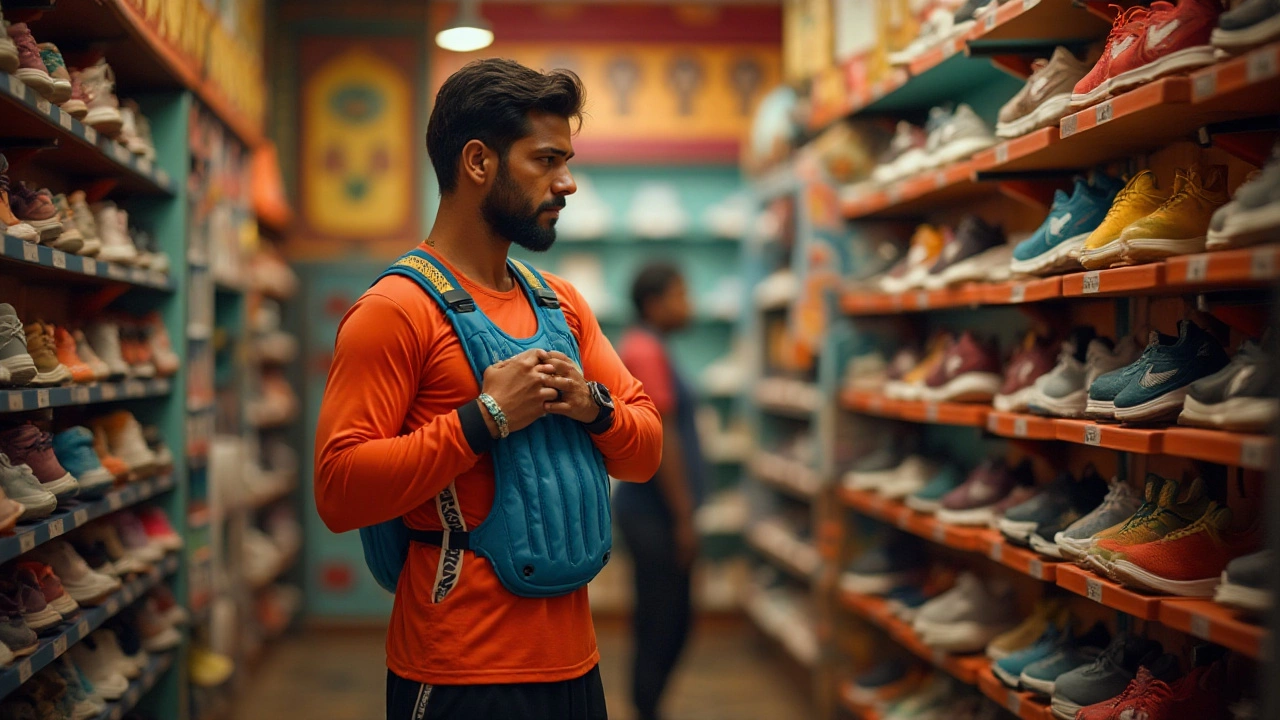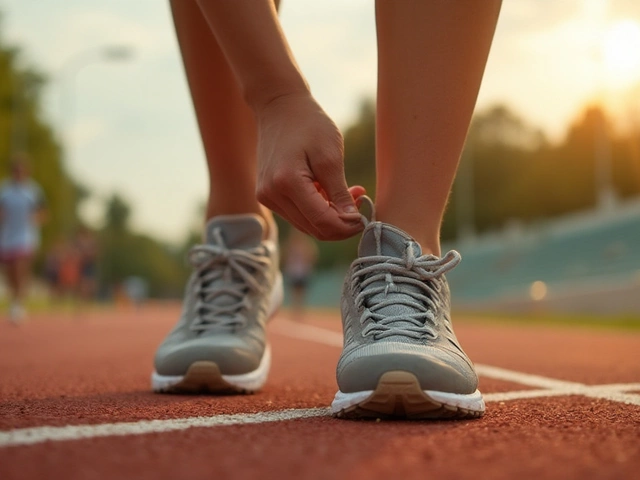When it comes to running, the fit of your shoes can make or break your experience. If you've ever heard the advice about going a size up in your running shoes, you might wonder if it's indeed the best choice.
Running is a dynamic activity that places unique demands on your feet. Understanding how your feet behave during running can help shed light on whether a larger shoe size could benefit you. With countless runners debating the right shoe fit, it's important to look closely at how shoe size impacts comfort and performance.
In this guide, we will navigate the common myths, share practical tips, and equip you with the knowledge you need to make confident choices about your running shoe size. Whether you're preparing for your first marathon or simply enjoy daily jogs, finding the right fit might just be the game changer you've been searching for.
- Understanding Foot Dynamics During Running
- Why a Larger Shoe Size Might Be Suggested
- Common Mistakes in Choosing Running Shoe Sizes
- Proper Steps to Determine Your Ideal Fit
- Expert Tips for Long-Lasting Comfort and Performance
Understanding Foot Dynamics During Running
Running is far more complex than simply putting one foot in front of the other at a fast pace. It's an intricate dance of muscles, bones, and tendons, all working synergistically to propel you forward. Each step triggers a chain reaction throughout your body, beginning the moment your heel strikes the ground. The impact forces the arch of your foot to flex and absorb shock, a function crucial to protecting your joints from injury. This is why the fit of your running shoes is paramount; any discrepancy in size can throw off this finely tuned process.
A fascinating aspect of foot dynamics is the natural expansion that occurs during a run. As you pound the pavement, increased blood flow causes your feet to swell, sometimes expanding as much as half a shoe size. This phenomenon is why runners are often advised to opt for a half or full size larger when selecting their shoes. The idea is to accommodate this natural expansion and prevent discomfort or bruising from a tight fit. According to a study published in the Journal of Orthopaedic & Sports Physical Therapy, foot expansion is a common yet overlooked aspect of running that contributes significantly to the wearer's overall experience.
Given the repetitive nature of running—often comprising thousands of steps within a single session—the way your foot lands and pushes off can directly influence your performance and risk of injury. When fitting your shoes, it's crucial to account for different terrains and running styles. Trail runners, for instance, may experience different foot dynamics compared to those running on asphalt due to the uneven surfaces and varied elevations. A shoe that offers a larger toe box can provide much-needed room for the toes to spread naturally, enhancing stability and comfort during long runs.
An often-cited piece of advice from experienced runners is, "Listen to your feet." This means paying attention to any discomfort or fatigue, as these can be indicators that your shoe size isn't suitable. Dr. Irene Davis, a renowned expert in running biomechanics, mentions in her studies that improper shoe fit doesn't just affect your feet; it can lead to pain and overuse injuries in the knees and hips.
"The key is finding a balance between snugness and roominess, ensuring no unnecessary friction occurs during the stride," Davis states.Understanding the role of your foot dynamics during running not only aids in selecting the right running shoe size but also in enhancing the overall quality of your run. Armed with this knowledge, you'll be better equipped to choose shoes that enable, rather than inhibit, your running endeavors.
Why a Larger Shoe Size Might Be Suggested
Heads up: your feet often perform a little magic between the start and end of your run. Countless runners find that their feet swell during exercise, a natural response to increased blood flow and muscular engagement. It's this natural phenomenon that plants the seed for the age-old suggestion to consider shoes a size bigger. Running shoes that feel snug before a workout might pinch or cause discomfort after few miles, resulting in blisters or bruised toenails. Professional athletes and outright novices alike have noticed how wearing a slightly larger size can offer a more forgiving environment for changing feet.
It's not just about comfort—it's about performance, too. Shoes that are too tight can restrict your foot's natural movement, hindering your stride and possibly leading to a less efficient run. In fact, a running shoe with just the right amount of room can be the difference between a painful hobble and a triumphant finish. This notion finds its roots in the growing understanding of the mechanical maintenance needed for sustainable athleticism. With every impact, your foot expands; without enough room, that persistent pressure could end in injuries we've all been warned about.
Customarily, experts suggest about a thumbnail's length of space between the toes and the shoe's front. This small additional space can be critical on longer runs. In conversation with running fit professionals, some emphasize that leaving a bit of space aids in distributing pressure more evenly across the foot.
Harvard's Dr. Irene Davis, an expert in biomechanics, once remarked, "A good fit isn't just about where the shoe ends—it's about how your foot behaves inside the shoe."This kind of expert advice echoes throughout running forums and recreational clubs, marking a square meter on the runners’ lore.
Still, a suggestion isn't a rule. Each runner's needs vary based on foot volume, arch shape, and even personal preference. For those with wide feet, a larger size might counteract the narrower toe boxes found in some running shoes. But for others with a more narrow, elongated foot profile, simply adjusting the lacing technique might suffice. In this regard, dialing into your own foot anatomy holds as much ground as the pieces of advice tossed around running tracks.
A quick trip to a specialized running store can do wonders. Knowledgeable staff often have techniques to measure your feet dynamically, accounting for how they might flex and swell. Testing shoes at different times of the day can further illuminate the shifts in foot size, helping runners determine the most appropriate fit. Here’s a small insider tip: try shoes on in the late afternoon or evening, when foot swelling naturally peaks. Coupled with a lively conversation about your running habits, engaging with the right expert can help fine-tune what ‘sizing up’ truly means for you.

Common Mistakes in Choosing Running Shoe Sizes
Choosing the right shoe size is a crucial part of any runner’s journey, yet it is surprisingly common for individuals to make missteps along the way. One frequent error is basing the decision solely on your regular shoe size without taking into account the specific needs of your running stride and footwear dynamics. Everyday shoes are often chosen for aesthetics or casual comfort, which differ significantly from the functional requirements of running shoes. This discrepancy can lead to discomfort, reduced performance, and even injuries.
Another typical mistake involves neglecting the changes in foot size that occur during a run. It’s a well-documented fact that feet swell during exercise, so trying on running shoes when your feet are at their smallest may lead to a tight fit that feels fine in-store but becomes unbearable after a few miles. Experts often recommend trying shoes in the late afternoon or after a light jog to account for this natural expansion. Being informed about the anatomical changes that happen while running can greatly influence your shoe choice for the better.
Moreover, relying on online reviews without considering personal foot shape is another pitfall. While reviews provide useful insights and highlight prevalent issues, they cannot fully replace the personalized fit that a store visit offers. This is why it’s advantageous to regard feedback as a general guide but always personalize choices based on your own foot contours. Visiting a specialized store for a gait analysis can provide tailored advice, helping you select shoes that cater specifically to your step and rhythm.
There's a popular saying among experienced runners: "Your running shoes are an extension of your body." This holds truth yet is often overlooked when cross-referencing different brands. Shoe sizing can vary between brands, similar to clothing, and a size 9 in one brand might be different from a size 9 in another. This makes it essential to try on shoes from different manufacturers if you're considering switching brands, rather than sticking with a preconceived size.
The Risk of Impulsive Decisions
Finally, many novice runners make the mistake of rushing their shoe selection in a bid to hit the track sooner. Impulse buys, swayed by flashy designs and attractive clearance deals, often result in opting for shoes that don’t align with your foot's needs. It’s vital to resist urgency in favor of thoughtful assessment and consideration.According to a survey conducted by Runners' World, 70% of runners reported improved comfort and reduced injuries after seeking professional advice for shoe fitting.
“The right pair of running shoes can be the difference between lifelong fitness and unnecessary pain,” says Dr. John DiFiori, Chief of Sports Medicine at Harvard University.These statistics emphasize the significance of choosing shoes wisely, acknowledging both science and personal sensation.
Proper Steps to Determine Your Ideal Fit
Choosing the right running shoes begins long before you step into a store. The process starts with understanding the needs of your feet. Begin by determining your foot shape and arch type, which play significant roles in providing the right support and comfort. Whether you have flat feet, high arches, or something in between, knowing this can guide you towards shoes that offer the necessary stability and cushioning. A wide selection of shoe brands cater to different foot types, so knowing your unique characteristics can simplify the buying process.
It’s a good idea to measure your feet later in the day since they naturally swell throughout the day and especially after a run. Use a reliable measuring tool to get the length and width of both feet, as they might differ slightly. Once you have your measurements, you can refer to the brand's sizing chart for guidance. Many runners make the mistake of assuming their usual shoe size will suffice, unaware that running fit may require adjustments. Be mindful that different brands have varying size scales, so cross-referencing is essential. This strategy reduces the likelihood of purchasing the wrong size and ending up with discomfort or injuries.
The Try-On Process: What to Look For
As you transition to trying on shoes, there are crucial considerations to keep in mind for a proper fit. Wear the same types of socks that you plan to use while running to mimic the environment your feet will be in during runs. As you lace up, ensure there’s enough room to wiggle your toes freely. A thumb's width between the longest toe and the shoe's end is a common recommendation. This extra space allows for natural expansion of the foot during impact. Pay attention also to the heel fit; the shoe should cradle your heel snugly to prevent slipping.
"According to the American College of Foot and Ankle Surgeons, proper shoe fitting requires that there is adequate space in the toe box and a secure fit around the heel to prevent sliding and additional stress on the toes."
Take your potential new shoes for a test run within the store. Some specialty stores have treadmills which can simulate running conditions. Move around in the shoes, noticing pressure points or areas of irritation. Comfort should be the ultimate priority; even a small discomfort can magnify over miles. Remember, while aesthetics are appealing, functionality needs to be the driving force behind your decision.
Listening to Your Feet and Mind
After purchasing your shoes, the relationship with them continues as you integrate them into your running routine. Initially, wear them for short distances to allow your body to acclimate to the new support and structure. It's a period of trial where you'll detect if the shoe size was accurately chosen. Your body will give signals if something is amiss, like blisters or joint pain. Listen to these cues—the size might need reevaluation.
If data helps you make informed decisions, consider the below statistics from a study published in the Journal of Sports Science and Medicine, indicating that 72% of runners opt for the wrong shoe size, with the most common issue being shoes that are too small. The longevity and health of your running journey depend on taking these steps towards fitting and monitoring seriously, and ensuring consistent checks through time may prevent long-term injuries.

Expert Tips for Long-Lasting Comfort and Performance
When it comes to running, enthusiasts and casual joggers alike know that a comfortable and well-fitted pair of running shoes can make all the difference in performance and enjoyment. A key tip often cited by experts is to not only focus on size but also on the shape and design of the shoe, as different brands cater to different foot types, such as flat, neutral, and high arches. Considering your foot type can dramatically affect your comfort, so getting this right should be a priority. Additionally, understanding that feet tend to swell during a run may influence your decision on sizing. A snug fit at the start can become uncomfortably tight after a few miles, leading many experienced runners to advise trying on shoes late in the day, when feet are naturally a bit larger.
Choosing a shoe with the right cushioning is another vital aspect that directly impacts both comfort and performance. Cushioning does not only provide comfort but also aids in shock absorption, protecting joints from the repetitive impact of running. Different surfaces, like trails versus pavement, may require different levels of cushioning. While some runners prefer the feel of a minimalist shoe to stay close to the ground, others might opt for a maximum cushioned shoe for additional support during longer runs. The choice depends on your personal preference and running style.
Another useful tip for ensuring comfort is paying attention to the material of the shoe. Today, running shoes are manufactured using various high-tech materials designed to wick away moisture, enhance breathability, and prevent common issues such as blisters and hotspots. Shoes featuring mesh uppers are praised for their ventilation properties especially during hot weather running. Durable materials also ensure that the shoes hold up well over time, providing lasting performance even with frequent use. Some experts suggest rotating between two pairs of running shoes, which allows the cushioning and support to ‘recharge’ between uses.
"It's not just about the size or the brand, but about how the shoe fits with your run and your foot," emphasizes George Hirsch, a leading expert in the field of sports footwear.Attention to these details can greatly enhance your running experience, preventing discomfort or injury. Moreover, changing your shoe size selection based on these variables may also be recommended. Engaging with seasoned professionals at specialty running stores can provide valuable advice tailored to individual needs. They often have knowledge about the latest technologies in footwear and access to a range of shoe brands and styles.
Finally, remember that regular and consistent maintenance of your running shoes plays a crucial role in ensuring their longevity and performance. Clean your shoes occasionally by removing the insoles, rinsing off grit and dirt, and allowing them to air dry naturally. Never expose them directly to heat sources, such as a heater, as this can damage the materials. Shoes generally have a lifespan of 300 to 500 miles, depending on various factors including running style, terrain, and personal technique. Paying close attention to signs of wear and tear such as uneven treads can help in deciding when it’s time to replace them, preventing potential injuries caused by worn-out shoes.
By considering these footwear tips, you can help ensure that each stride in your running journey is as comfortable and effective as possible, allowing you to enjoy the true essence of the run.





